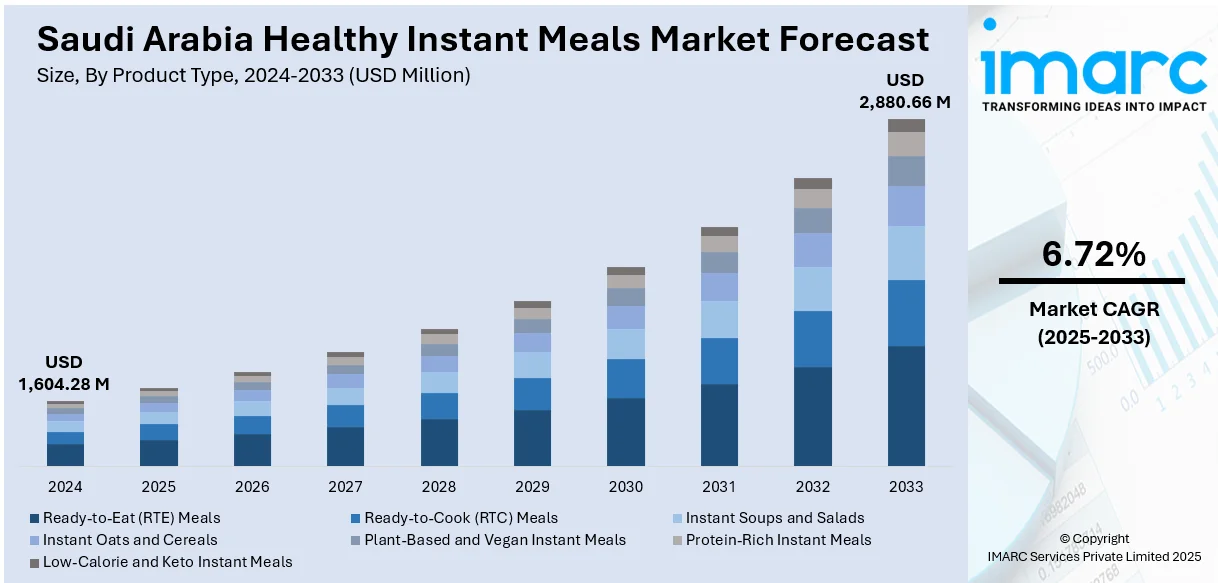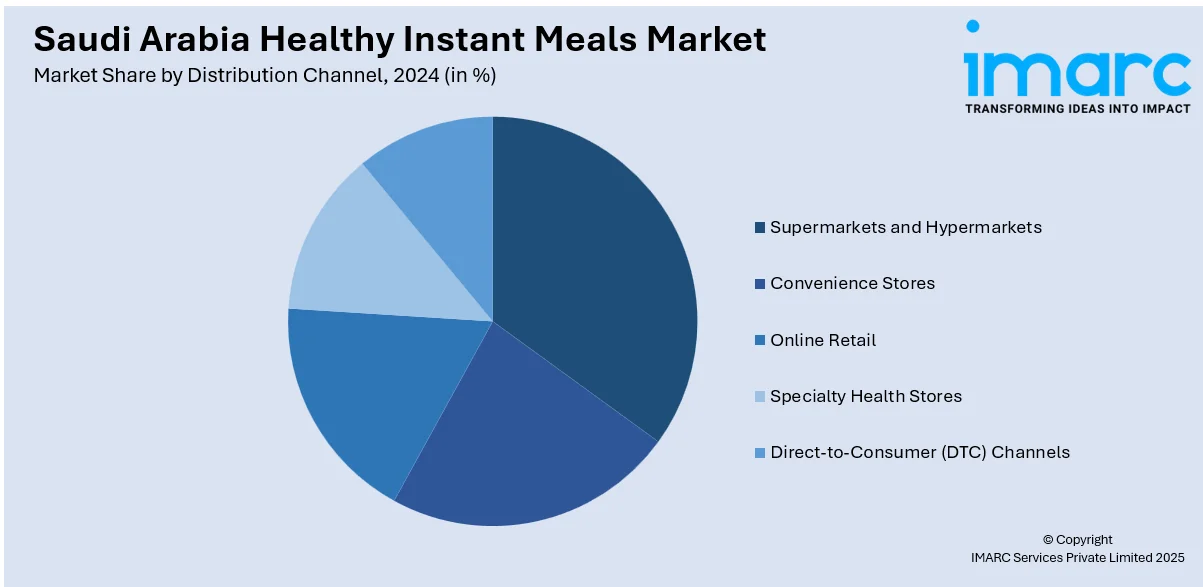
Saudi Arabia Healthy Instant Meals Market Size, Share, Trends and Forecast by Product Type, Ingredient Type, Packaging Type, Distribution Channel, End User, and Region, 2025-2033
Saudi Arabia Healthy Instant Meals Market Overview:
The Saudi Arabia healthy instant meals market size reached USD 1,604.28 Million in 2024. Looking forward, IMARC Group expects the market to reach USD 2,880.66 Million by 2033, exhibiting a growth rate (CAGR) of 6.72% during 2025-2033. The market is driven by rising demand for convenient, health-oriented food among busy urban professionals and youth. Government-led health initiatives and labeling reforms are pushing brands toward cleaner, lower-sodium formulations, thereby fueling the market. Expanding e-commerce and digital wellness trends are increasing product visibility and access, further augmenting the Saudi Arabia healthy instant meals market share.
|
Report Attribute
|
Key Statistics
|
|---|---|
|
Base Year
|
2024 |
|
Forecast Years
|
2025-2033
|
|
Historical Years
|
2019-2024
|
| Market Size in 2024 | USD 1,604.28 Million |
| Market Forecast in 2033 | USD 2,880.66 Million |
| Market Growth Rate 2025-2033 | 6.72% |
Saudi Arabia Healthy Instant Meals Market Trends:
Rapid Lifestyle Modernization and Convenience-Centric Consumption
The transformation of Saudi Arabia’s urban landscape and work culture is altering food consumption patterns, especially among the youth and middle-class professionals. With long commutes, extended working hours, and dual-income households becoming more common, consumers are seeking convenient meal solutions that align with their growing health awareness. Healthy instant meals, which balance ease of preparation with nutritional value, are gaining significant popularity across retail and online platforms. These products, often low in sodium, free from preservatives, and enriched with whole grains or lean proteins, cater to evolving dietary expectations. The trend is particularly pronounced in cities like Riyadh and Jeddah, where modern lifestyles are reducing traditional meal preparation time. Ready-to-eat soups, single-serve rice meals, and health-labeled entrees are occupying more shelf space in supermarkets, convenience stores, and digital marketplaces. On May 13, 2025, Red Planet, a UAE-based company specializing in food innovation, showcased its advanced freeze-drying technology at the Saudi Food Show 2025. This technology, which keeps products fresh for up to 25 years without using any artificial preservatives, was highlighted as a solution for food sustainability and emergency preparedness. The company’s offerings include ready-made meals, suitable for both daily consumption and long-term storage. Red Planet’s freeze-drying process removes over 95% of moisture from the food, preserving taste and nutritional value, making it ideal for instant meals and critical situations. Furthermore, increased microwave and appliance penetration enhances product usability, even in conservative household settings. As meal decisions become more time-sensitive, buyers are more likely to choose trusted brands that offer transparency, health-focused innovation, and product reliability. This shift in behavior among busy consumers is a major catalyst for Saudi Arabia healthy instant meals market growth.

To get more information on this market, Request Sample
Digital Retail Expansion and Youth-Led Wellness Trends
The rapid growth of digital commerce in Saudi Arabia is transforming how consumers access and engage with healthy food products. With high internet penetration and mobile-first behavior, e-commerce platforms and food delivery apps now play a central role in shaping instant meal consumption habits. Young Saudi consumers, digitally native and globally influenced, are increasingly drawn to wellness-branded meal solutions that are ready-to-eat, transparent in ingredients, and designed around fitness or dietary goals. Subscription-based meal services and influencer-led promotions are popularizing low-carb, high-protein, and plant-based options. Platforms such as HungerStation, Nana, and Amazon.sa have created dedicated health food sections that highlight nutritional facts, allergen info, and product certifications, improving discoverability. As of March 2025, the ready-to-eat meals market in Saudi Arabia is projected to reach USD 3.32 billion in revenue in 2025, growing at an annual rate of 3.21% (CAGR 2025-2030). The market is driven by changing consumer preferences, with increasing demand for healthier and more nutritious ready-made meals, especially as urbanization and busy lifestyles contribute to the popularity of convenient food options. In 2025, per capita revenue is expected to be USD 96.05, and the volume of the market is projected to be 524.91 million kg by 2030, with an average consumption of 14.5 kg per person. Small and premium brands now have access to a broader customer base without relying solely on traditional supermarkets. Seasonal promotions tied to Ramadan, fitness challenges, or national health events are further accelerating category awareness and trial. Packaging innovations, such as resealable pouches and microwavable trays, enhance user convenience and align with mobile, on-the-go consumption. As e-commerce continues to evolve and digitally savvy consumers seek balance between taste and health, this convergence is reinforcing the long-term viability of healthier instant meal options.
Saudi Arabia Healthy Instant Meals Market Segmentation:
IMARC Group provides an analysis of the key trends in each segment of the market, along with forecasts at the country and regional levels for 2025-2033. Our report has categorized the market based on product type, ingredient type, packaging type, distribution channel, and end user.
Product Type Insights:
- Ready-to-Eat (RTE) Meals
- Ready-to-Cook (RTC) Meals
- Instant Soups and Salads
- Instant Oats and Cereals
- Plant-Based and Vegan Instant Meals
- Protein-Rich Instant Meals
- Low-Calorie and Keto Instant Meals
The report has provided a detailed breakup and analysis of the market based on the product type. This includes ready-to-eat (RTE) meals, ready-to-cook (RTC) meals, instant soups and salads, instant oats and cereals, plant-based and vegan instant meals, protein-rich instant meals, and low-calorie and keto instant meals.
Ingredient Type Insights:
- Organic and Natural Ingredients
- Plant-Based Ingredients
- Gluten-Free Ingredients
- Protein-Fortified Ingredients
The report has provided a detailed breakup and analysis of the market based on the ingredient type. This includes organic and natural ingredients, plant-based ingredients, gluten-free ingredients, and protein-fortified ingredients.
Packaging Type Insights:
- Pouches
- Cups and Bowls
- Trays and Boxes
- Cans and Bottles
The report has provided a detailed breakup and analysis of the market based on the packaging type. This includes pouches, cups and bowls, trays and boxes, and cans and bottles.
Distribution Channel Insights:

- Supermarkets and Hypermarkets
- Convenience Stores
- Online Retail
- Specialty Health Stores
- Direct-to-Consumer (DTC) Channels
The report has provided a detailed breakup and analysis of the market based on the distribution channel. This includes supermarkets and hypermarkets, convenience stores, online retail, specialty health stores, and direct-to-consumer (DTC) channels.
End User Insights:
- Working Professionals
- Students
- Fitness Enthusiasts
- Travelers and Outdoor Consumers
The report has provided a detailed breakup and analysis of the market based on the end user. This includes working professionals, students, fitness enthusiasts, and travelers and outdoor consumers.
Regional Insights:
- Northern and Central Region
- Western Region
- Eastern Region
- Southern Region
The report has also provided a comprehensive analysis of all major regional markets. This includes Northern and Central Region, Western Region, Eastern Region, and Southern Region.
Competitive Landscape:
The market research report has also provided a comprehensive analysis of the competitive landscape. Competitive analysis such as market structure, key player positioning, top winning strategies, competitive dashboard, and company evaluation quadrant has been covered in the report. Also, detailed profiles of all major companies have been provided.
Saudi Arabia Healthy Instant Meals Market News:
- On October 31, 2023, SADAFCO (Saudi Dairy and Foodstuff Company) partnered with Kasih Food Production Company to expand its presence in Saudi Arabia's growing food sector. This collaboration will introduce a new range of healthy, plant-based, gluten-free, and preservative-free products under the SAUDIA by Mezete brand, including instant hummus, healthy baba ghanouj, tahini sauce, and the innovative Koshna meal maker, designed to enhance the homemade cooking experience.
Saudi Arabia Healthy Instant Meals Market Report Coverage:
| Report Features | Details |
|---|---|
| Base Year of the Analysis | 2024 |
| Historical Period | 2019-2024 |
| Forecast Period | 2025-2033 |
| Units | Million USD |
| Scope of the Report |
Exploration of Historical Trends and Market Outlook, Industry Catalysts and Challenges, Segment-Wise Historical and Future Market Assessment:
|
| Product Types Covered | Ready-to-Eat (RTE) Meals, Ready-to-Cook (RTC) Meals, Instant Soups and Salads, Instant Oats and Cereals, Plant-Based and Vegan Instant Meals, Protein-Rich Instant Meals, Low-Calorie and Keto Instant Meals |
| Ingredient Types Covered | Organic and Natural Ingredients, Plant-Based Ingredients, Gluten-Free Ingredients, Protein-Fortified Ingredients |
| Packaging Types Covered | Pouches, Cups and Bowls, Trays and Boxes, Cans and Bottles |
| Distribution Channels Covered | Supermarkets and Hypermarkets, Convenience Stores, Online Retail, Specialty Health Stores, Direct-to-Consumer (DTC) Channels |
| End Users Covered | Working Professionals, Students, Fitness Enthusiasts, Travelers and Outdoor Consumers |
| Regions Covered | Northern and Central Region, Western Region, Eastern Region, Southern Region |
| Customization Scope | 10% Free Customization |
| Post-Sale Analyst Support | 10-12 Weeks |
| Delivery Format | PDF and Excel through Email (We can also provide the editable version of the report in PPT/Word format on special request) |
Key Questions Answered in This Report:
- How has the Saudi Arabia healthy instant meals market performed so far and how will it perform in the coming years?
- What is the breakup of the Saudi Arabia healthy instant meals market on the basis of product type?
- What is the breakup of the Saudi Arabia healthy instant meals market on the basis of ingredient type?
- What is the breakup of the Saudi Arabia healthy instant meals market on the basis of packaging type?
- What is the breakup of the Saudi Arabia healthy instant meals market on the basis of distribution channel?
- What is the breakup of the Saudi Arabia healthy instant meals market on the basis of end user?
- What is the breakup of the Saudi Arabia healthy instant meals market on the basis of region?
- What are the various stages in the value chain of the Saudi Arabia healthy instant meals market?
- What are the key driving factors and challenges in the Saudi Arabia healthy instant meals market?
- What is the structure of the Saudi Arabia healthy instant meals market and who are the key players?
- What is the degree of competition in the Saudi Arabia healthy instant meals market?
Key Benefits for Stakeholders:
- IMARC’s industry report offers a comprehensive quantitative analysis of various market segments, historical and current market trends, market forecasts, and dynamics of the Saudi Arabia healthy instant meals market from 2019-2033.
- The research report provides the latest information on the market drivers, challenges, and opportunities in the Saudi Arabia healthy instant meals market.
- Porter's five forces analysis assist stakeholders in assessing the impact of new entrants, competitive rivalry, supplier power, buyer power, and the threat of substitution. It helps stakeholders to analyze the level of competition within the Saudi Arabia healthy instant meals industry and its attractiveness.
- Competitive landscape allows stakeholders to understand their competitive environment and provides an insight into the current positions of key players in the market.
Need more help?
- Speak to our experienced analysts for insights on the current market scenarios.
- Include additional segments and countries to customize the report as per your requirement.
- Gain an unparalleled competitive advantage in your domain by understanding how to utilize the report and positively impacting your operations and revenue.
- For further assistance, please connect with our analysts.
 Request Customization
Request Customization
 Speak to an Analyst
Speak to an Analyst
 Request Brochure
Request Brochure
 Inquire Before Buying
Inquire Before Buying




.webp)




.webp)












